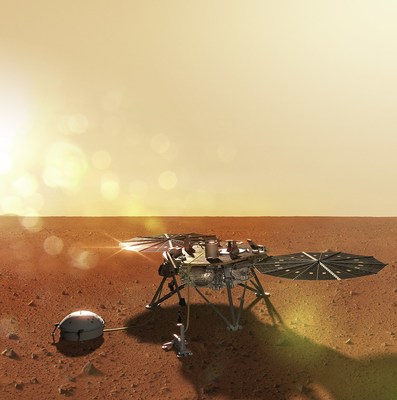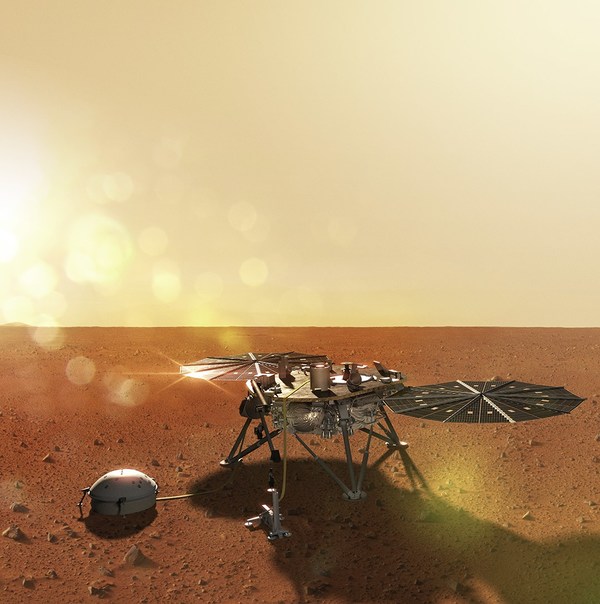Releases
DENVER, Nov. 26, 2018 /PRNewswire/ -- NASA has a new spacecraft operating on the surface of Mars. This afternoon, the InSight Mars Lander, which was designed, built and tested by Lockheed Martin (NYSE: LMT), navigated the dramatic entry and descent through the Martian atmosphere and touched down on Elysium Planitia in the equatorial region of Mars. Lockheed Martin is the prime contractor responsible for the complete spacecraft system – cruise stage, aeroshell and the lander itself. Mission management and navigation were handled by NASA Jet Propulsion Laboratory (JPL) and spacecraft operations were performed by engineers at Lockheed Martin Space's Mission Support Area in Littleton, Colorado.

At 12:47 p.m. MST, onboard software commands, developed by Lockheed Martin, fired six separation nuts and jettisoned the cruise stage of the spacecraft while it was 78 miles above the surface. That started a series of events that took the spacecraft through six different configurations and from a speed of 12,300 mph to a gentle touchdown on the surface. The data signal confirming the spacecraft had successfully landed was received on Earth at 12:52 p.m. MST.
"The InSight lander is a remarkable spacecraft. Through the entire entry, descent and landing it performed flawlessly," said Stu Spath, InSight program manager and director of Deep Space Exploration at Lockheed Martin Space. "NASA's JPL, which has been a pioneer in Mars exploration for decades, partners with both academia and private industry to bring the best expertise and innovation forward to make important exploration missions like InSight a success."
After landing, the spacecraft waited approximately seven minutes to use its X-band small deep space transponder to send a tone confirming the health of the spacecraft. Then, 25 minutes after that, the lander deployed its two solar arrays, with a width of 19 feet, 8 inches, to begin recharging the spacecraft's batteries
Two NASA orbiters, Mars Reconnaissance Orbiter (MRO) and 2001 Mars Odyssey, were also involved in this historic mission. MRO received and recorded InSight data during its journey to the surface, and will send it back to Earth later today. Both MRO and Odyssey will provide UHF relay during the entirety of the InSight surface mission – Odyssey in the morning and MRO in the afternoon. Both MRO and Odyssey spacecraft were built by Lockheed Martin and both are operated for JPL by the company.
Lockheed Martin has been an industry partner with NASA and the JPL for more than four decades in the exploration of the surface of Mars. Beginning in 1976 with Viking missions, Lockheed Martin has been at the forefront in the development of eleven Mars-bound spacecraft and has played a significant role in all NASA missions to Mars.
"Our team is thrilled by the successful landing of the InSight spacecraft," Lisa Callahan, vice president and general manager of Commercial Civil Space at Lockheed Martin Space. "With missions like this, there are no guarantees; historically, less than half of the world's missions to Mars have been successful. Every arrival at another planet is an incredibly complex engineering challenge. But that's what we do best at Lockheed Martin. It's an honor for us to partner with NASA and JPL on yet another Mars mission."
JPL manages InSight for NASA's Science Mission Directorate. InSight is part of NASA's Discovery Program, managed by the agency's Marshall Space Flight Center in Huntsville, Alabama. Lockheed Martin Space in Denver built the InSight spacecraft, including its cruise stage and lander, and supports spacecraft operations for the mission.
A number of European partners, including France's Centre National d'Études Spatiales (CNES), the Institut de Physique du Globe de Paris (IPGP) and the German Aerospace Center (DLR), are supporting the InSight mission. CNES and IPGP provided the Seismic Experiment for Interior Structure (SEIS) instrument, with significant contributions from the Max Planck Institute for Solar System Research (MPS) in Germany, the Swiss Institute of Technology (ETH) in Switzerland, Imperial College and Oxford University in the United Kingdom, and JPL. DLR provided the Heat Flow and Physical Properties Package (HP3) instrument, with significant contributions from the Space Research Center (CBK) of the Polish Academy of Sciences and Astronika in Poland. Spain's Centro de Astrobiología (CAB) supplied the wind sensors.
About Lockheed Martin:
Headquartered in Bethesda, Maryland, Lockheed Martin (NYSE: LMT) is a global security and aerospace company that employs approximately 100,000 people worldwide and is principally engaged in the research, design, development, manufacture, integration and sustainment of advanced technology systems, products and services.

SOURCE Lockheed Martin



